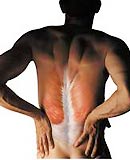To treat back pain, you cannot rely solely on medication; you also need to combine it with exercise. Swimming is one of the best sports to help alleviate your back pain.
 |
| Exercising to cure back pain is an easy-to-implement solution but requires determination. |
Typically, when treating back pain, people use anti-inflammatory medications, pain relievers, and muscle relaxants. However, for individuals suffering from stomach or duodenal issues, these medications can lead to complications such as gastric bleeding or perforation. It is essential to combine medication with therapeutic exercise and appropriate sports for quick results and to minimize recurrence.
Exercise for Back Pain Relief
Exercising to alleviate back pain is a straightforward method, but it requires determination and consistent practice as guided by a healthcare professional.
Exercise should be performed slowly and gently, avoiding any movements that cause pain. Performing the correct movements, combined with deep, rhythmic breathing, gradually increasing intensity will enhance spinal flexibility and strengthen the muscles and ligaments in the back, promoting better spinal posture and reducing pain. Initially, medication may be used to relieve pain, after which the focus can shift solely to exercise and massage.
In the first phase, focus on stretching exercises to increase the flexibility of the spinal joints; once the pain diminishes or disappears, shift to strengthening exercises for the muscles and ligaments in the back.
Sports for Back Pain Relief
After a period of regular therapeutic exercises, if health improves and back pain symptoms decrease significantly, swimming, brisk walking, or a combination of brisk walking and small runs can be incorporated. Swimming is particularly well-suited for those with lower back pain due to underlying conditions, as brisk walking or running can increase the strain on the joints and may worsen spinal issues.
Why is swimming beneficial for individuals with back pain? In water, the effects of gravity are reduced. When swimming, the joints in the legs and spine are not subjected to the weight of the body. This enhances cardiovascular and respiratory function, develops overall endurance without stressing the joints. Furthermore, swimming strengthens the back muscles, improves joint nourishment, and can slow down the degenerative processes in the joints, reducing the frequency of recurrence of back pain.
Due to the unique properties of the aquatic environment, the burden on the circulatory system during swimming is lower than when running. Therefore, to achieve effective health benefits from swimming, one should gradually increase the swimming speed to reach a heart rate of over 125-130 beats per minute. The breathing techniques in swimming are challenging due to water pressure on the swimmer’s chest, which helps develop the respiratory system and increase lung capacity.
The resistance and thermal conductivity of water are significantly greater, leading to higher energy expenditure while swimming—approximately four times higher than walking at the same pace. Thus, swimming is an excellent method to reduce excess body weight. Obesity is a contributing factor to lower back pain and joint pain because excess fat adds extra strain on the muscles and joints, particularly the knees, hips, and lower back.
Additionally, the cold environment of water enhances the body’s resilience against adverse environmental factors (heat, cold…) as the body becomes conditioned. When the water stimulates the receptors on the skin, it increases the activity of bioelectric currents, energizing the nerve cells, balancing excitatory and inhibitory processes in the cerebral cortex, and quickly alleviating fatigue from mental stress.
To effectively use swimming for therapeutic purposes and to bolster health, one should swim three times a week (every other day), gradually increasing the duration of each session to 25-30 minutes. Regular and continuous training is essential. Gradually increase the swimming speed in each session so that the heart rate reaches 125-130 beats per minute.
Dr. Dang Quoc Bao


















































